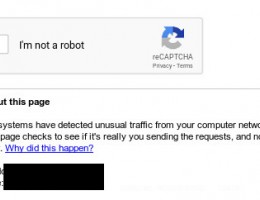¿Van juntas las palabras Google y Hacking? Bueno, si usted pensó que vamos a aprender cómo utilizar el hack en Google, usted podría estar equivocado.
Pero podemos Usar el motor de búsqueda de Google para encontrar datos interesantes accidentalmente expuestos en Internet.
Una barra de búsqueda tan simple tiene el potencial de ayudarle también a protegerse a sí mismo o a su sitio web contra las visitas no deseadas de los hackers. De esta manera, si usted es un operador o propietario de un sitio web puede tratar de averiguar lo que comparte con el mundo. ¡Si sabes CÓMO!
¿Qué es Google hacking?
Permítame presentarle a Google hacking, también conocido como Google dorking. Se trata de una técnica de "hacker", a veces llamada simplemente "dork", que utiliza la Búsqueda Avanzada de Google para encontrar agujeros de seguridad en la configuración y el código del sitio web.
Podemos utilizar algunas de estas técnicas para filtrar la información, obtener mejores resultados de búsqueda, pero en este caso, nos centraríamos en la información que normalmente no es accesible. Como por ejemplo, mostrar los feeds de las cámaras y los documentos..
Todo empezó en 2002 cuando un hombre llamado Johnny Long empezó a recopilar consultas que funcionaban en la búsqueda de Google y con las que se podían descubrir vulnerabilidades o desvelar información sensible u oculta. Los etiquetó como google dorks. Más tarde esto creció en una gran base de datos, eventualmente organizada en Google Hacking Database.
No es un hacking tonto..
Bueno, si usted argumentara que incluso el propio Google permite a sus usuarios la información de cómo se puede refinar la búsqueda, usted habría tenido razón.
Usted no puede hackear sitios web directamente usando Google, sólo está haciendo uso de las herramientas de búsqueda avanzada disponibles públicamente. Pero dado que Google utiliza las capacidades de su motor para rastrear Internet e indexar los títulos de las páginas, dentro de algunos sitios web poco seguros se puede incluir información sensible. Básicamente, mediante el rastreo se pueden encontrar vulnerabilidades.
Existen múltiples opciones para definir con mayor precisión la consulta en https://www.google.com/advanced_search, y si te fijas en la parte derecha de esa página hay incluso pistas.
Ya hemos hablado del uso de operadores y símbolos especiales como AND, OR, NOT, y símbolos como ~ (sinónimos), + (combinar), “” (frase exacta), * (wildcard) .
Pequeña recapitulación:
- Google search es sensible a las mayúsculas y minúsculas cuando utilizamos operadores lógicos. Por lo tanto, no se puede escribir oR, o anD, En su lugar, utilice las mayúsculas o los símbolos.
- OR puede sustituirse por el símbolo de la barra vertical | .
- NOT puede ser sustituido por el símbolo menos - .
- AND puede ser sustituido por un solo espacio (pulsando espacio), pero los resultados pueden ser diferentes si escribimos AND específicamente entre palabras.
- City City - mostrar vuelos de una ciudad a otra, incluso si se introduce el código de aeropuerto IATA como "PRG LON"
- Link - encuentra sitios que enlazan con su dominio específico, como "link:ma-no.org"
- .. - busca dentro de un rango de números, como '2002 .. 2020' o '$25..$75'
- In - convierte las unidades, por ejemplo "pulgadas en un pie".
- Site - muestra el término buscado dentro de un sitio específico, como 'site:elcorteingles.es watches' o un dominio específico 'site:uk amazon'
- Allintitle - muestra resultados con la frase buscada en el título, "allintitle:nasa moon landing
- Intitle - muestra el resultado con un solo término en el título, ejemplo 'intitle: "salsa"'
- Inblogtitle - muestra los resultados de los blogs con la frase buscada en el título, 'inblogtitle: programming'
- Inposttitle - muestra los resultados con un solo término en el título, como 'inposttitle: programming'
- Allintext - muestra los resultados a las páginas con los términos en el contenido, ejemplo 'Allintext: recetas para un fin de semana'
- Allinanchor - muestra los sitios con su término de búsqueda en los enlaces, ejemplo:
- Allinurl
- Inurl - muestra resultados con su primer término de búsqueda en la URL y el segundo término es el contenido, 'Inurl: movie view'
- Allinpostauthor - muestra el contenido que ha sido escrito por el autor buscado, por ejemplo 'allinpostauthor: Bukowski'
- Related - muestra los resultados relacionados con la URL buscada, 'related:NYtimes.com'
- Info - muestra información sobre el dominio buscado, como 'Info:diariodemallorca.com'
- Define - 'define:dorking' devolverá la definición de la palabra dada.
- Source - busca menciones de una persona o cosa específica en una determinada fuente de noticias. 'fuente metro:diario de mallorca'
- Location - muestra artículos basados en la ubicación especificada, como 'location:Mallorca beaches'
- Filetype - Busca documentos del tipo especificado, ejemplo 'filetype:pdf cats'
- Ext - Muy similar a Filetype pero podemos buscar extensiones poco comunes para obtener resultados más precisos, ejemplo 'ext:flac mysong'
- Movie - muestra los horarios de una película específica en un lugar concreto
- Weather - mostrar los resultados del tiempo en una ubicación específica, ejemplo "weather:palma de mallorca"
- Stocks - muestra el precio de las acciones de una empresa específica. Por ejemplo, "stocks:Starbucks".
- Cache - muestra el caché más reciente de una página web específica, por ejemplo 'cache:ma-no.org'
- Map - muestra el mapa de la ubicación especificada, como 'map: "sierra de tramuntana"'
- Equation - calcula números, por ejemplo '10x4'
- Tip calculator - calculadora para ayudarle a decidir cuánto dar de propina, ejemplo ''
- Minute timer - muestra un temporizador con el tiempo especificado, como 'temporizador de 2 minutos'
- Stopwatch - muestra un cronómetro, ejemplo 'stopwatch'
- Sunrise | Sunset - muestra la hora de salida y puesta del sol para una ubicación específica, ejemplo 'sunrise palma'
- Flight number - muestra el estado de un vuelo específico, ejemplo "FR 6363"
- Sports team - muestra el resultado de un partido actual 'real madrid barcelona'
- Insubject - Busca mensajes de grupo con contenido específico, como 'insubject: "website crawlers" '
- Group - Busca mensajes de grupo de una fuente específica, por ejemplo 'group: "google dorks" '
- Numrange - Encuentra un rango de números en una consulta de hasta 5 dígitos
- Daterange - Busca en un rango de fechas, con uso de fechas julianas, ejemplo 'daterange:2452463.5 2452464'
- Msgid - Línea de identificación de mensajes utilizada en el correo electrónico y en los grupos de noticias de Usenet.
En este artículo puede leer más sobre las consultas "secretas" de Google.
https://www.ma-no.org/en/security/google-hacking-secrets-the-hidden-codes-of-google.
Bonanza de datos, información jugosa y algunos ejemplos
Tenemos que asegurarnos de que no estamos entrando en nada que requiera una contraseña, incluso si esa contraseña se nos muestra en texto plano, porque esa es una línea en la que se convierte en acceso ilegal a un dispositivo que no tenemos permiso para usar.
También sería una buena idea utilizar algún proxy o VPN como hide.me para cambiar tu dirección IP cuando Google empiece a consultarte con captchas.

Esta consulta buscaría en los archivos de texto de los sitios que tienen el dominio .org y en el archivo de texto busca las cadenas "password OR passwords OR contraseñas OR login OR contraseña".
filetype:txt site:web.com password|passwords|contraseñas|login|contraseña
Esta consulta muestra los registros de las conversaciones que permanecieron en los servidores.
“Index of” / “chat/logs”
This searches for backup directories.
intitle:"index of" inurl:/backup
This searches mp3 files on various types of servers
intitle:index.of mp3
This shows spilled data from MySQL databases where you are searching for pass|password|passwd|pwd.
filetype:sql “MySQL dump” (pass|password|passwd|pwd)
We can use some of these techniques to localize cameras of the manufacturer AXIS.
Inurl:axis-cgi
Inurl:"lvappl.htm"
We can obtain some feed of the IP cameras, some of them we can even control.
inurl:”ViewerFrame?Mode=”
If you’re into webcams, here is good source of query strings. Its a bit creepy if you ever wondered if somebody could be watching some(yours) feed?
http://suryachandiran.blogspot.com/2015/05/google-hacking-to-hack-into-live.html
inurl:top.htm inurl:currenttime
inurl:”lvappl.htm”
This can show enjoyable reading among government sited files of type PDF.
site:gov filetype:pdf allintitle:restricted
This query searches documents with sensitive character, but in the intranet of the sites.
inurl:intranet filetype:doc confidential
This is supposed to find the .LOG files accidentally exposed on the internet.
allintext:password filetype:log after:2020
This searches for string “username” in a log type files
allintext:username filetype:log
This will expose .env files - used by various popular web development frameworks to declare general variables and configurations for local as well as dev environment.
DB_USERNAME filetype:env
DB_PASSWORD filetype:enc=v
The file robots.txt is for preventing crawlers and spiders or any other search engine to enter into your website and you can block indexing specific pages or directories with it. Anyhow, by typing a query like this, you can look into different robots.txt files to see what you are not able to access.
“robots.txt” “disallow:” filetype:txt
These queries help you browse open FTP servers
intitle:"index of" inurl:ftp
intitle:"index of" inurl:http after:2020
Search for specific website under defined domain
inurl:.es/index.php?id=
SSH private keys
intitle:index.of id_rsa -id_rsa.pub
Putty logs
filetype:log username putty
Email lists
filetype:xls inurl:"email.xls"
Cómo mitigar el Dorking
Hay formas de no exponer su sistema. Mantenga el sistema operativo, los servicios y las aplicaciones parcheados y actualizados. Utilice soluciones de seguridad como antivirus y cortafuegos para bloquear el acceso. Audite su exposición. No almacene información sensible en lugares públicos. Realice pruebas de penetración.
Los propietarios de sitios web deben configurar correctamente un archivo con el nombre de robots.txt. Esto es para evitar que los Google Dorks accedan a datos importantes de su sitio, lo que puede tener graves consecuencias para su imagen y reputación.
xplanations:
cache: If you include other words in the query, Google will highlight those words within
the cached document. For instance, [cache:www.google.com web] will show the cached
content with the word “web” highlighted. This functionality is also accessible by
clicking on the “Cached” link on Google’s main results page. The query [cache:] will
show the version of the web page that Google has in its cache. For instance,
[cache:www.google.com] will show Google’s cache of the Google homepage. Note there
can be no space between the “cache:” and the web page url.
------------------------------------------------------------------------------------------
link: The query [link:] will list webpages that have links to the specified webpage.
For instance, [link:www.google.com] will list webpages that have links pointing to the
Google homepage. Note there can be no space between the “link:” and the web page url.
------------------------------------------------------------------------------------------
related: The query [related:] will list web pages that are “similar” to a specified web
page. For instance, [related:www.google.com] will list web pages that are similar to
the Google homepage. Note there can be no space between the “related:” and the web
page url.
------------------------------------------------------------------------------------------
info: The query [info:] will present some information that Google has about that web
page. For instance, [info:www.google.com] will show information about the Google
homepage. Note there can be no space between the “info:” and the web page url.
------------------------------------------------------------------------------------------
define: The query [define:] will provide a definition of the words you enter after it,
gathered from various online sources. The definition will be for the entire phrase
entered (i.e., it will include all the words in the exact order you typed them).
------------------------------------------------------------------------------------------
stocks: If you begin a query with the [stocks:] operator, Google will treat the rest
of the query terms as stock ticker symbols, and will link to a page showing stock
information for those symbols. For instance, [stocks: intc yhoo] will show information
about Intel and Yahoo. (Note you must type the ticker symbols, not the company name.)
------------------------------------------------------------------------------------------
site: If you include [site:] in your query, Google will restrict the results to those
websites in the given domain. For instance, [help site:www.google.com] will find pages
about help within www.google.com. [help site:com] will find pages about help within
.com urls. Note there can be no space between the “site:” and the domain.
------------------------------------------------------------------------------------------
allintitle: If you start a query with [allintitle:], Google will restrict the results
to those with all of the query words in the title. For instance,
[allintitle: google search] will return only documents that have both “google”
and “search” in the title.
------------------------------------------------------------------------------------------
intitle: If you include [intitle:] in your query, Google will restrict the results
to documents containing that word in the title. For instance, [intitle:google search]
will return documents that mention the word “google” in their title, and mention the
word “search” anywhere in the document (title or no). Note there can be no space
between the “intitle:” and the following word. Putting [intitle:] in front of every
word in your query is equivalent to putting [allintitle:] at the front of your
query: [intitle:google intitle:search] is the same as [allintitle: google search].
------------------------------------------------------------------------------------------
allinurl: If you start a query with [allinurl:], Google will restrict the results to
those with all of the query words in the url. For instance, [allinurl: google search]
will return only documents that have both “google” and “search” in the url. Note
that [allinurl:] works on words, not url components. In particular, it ignores
punctuation. Thus, [allinurl: foo/bar] will restrict the results to page with the
words “foo” and “bar” in the url, but won’t require that they be separated by a
slash within that url, that they be adjacent, or that they be in that particular
word order. There is currently no way to enforce these constraints.
------------------------------------------------------------------------------------------
inurl: If you include [inurl:] in your query, Google will restrict the results to
documents containing that word in the url. For instance, [inurl:google search] will
return documents that mention the word “google” in their url, and mention the word
“search” anywhere in the document (url or no). Note there can be no space between
the “inurl:” and the following word. Putting “inurl:” in front of every word in your
query is equivalent to putting “allinurl:” at the front of your query:
[inurl:google inurl:search] is the same as [allinurl: google search].
------------------------------------------------------------------------------------------
Nina Simone intitle:”index.of” “parent directory” “size” “last modified” “description” I Put A Spell On You (mp4|mp3|avi|flac|aac|ape|ogg) -inurl:(jsp|php|html|aspx|htm|cf|shtml|lyrics-realm|mp3-collection) -site:.info
Bill Gates intitle:”index.of” “parent directory” “size” “last modified” “description” Microsoft (pdf|txt|epub|doc|docx) -inurl:(jsp|php|html|aspx|htm|cf|shtml|ebooks|ebook) -site:.info
parent directory /appz/ -xxx -html -htm -php -shtml -opendivx -md5 -md5sums
parent directory DVDRip -xxx -html -htm -php -shtml -opendivx -md5 -md5sums
parent directory Xvid -xxx -html -htm -php -shtml -opendivx -md5 -md5sums
parent directory Gamez -xxx -html -htm -php -shtml -opendivx -md5 -md5sums
parent directory MP3 -xxx -html -htm -php -shtml -opendivx -md5 -md5sums
parent directory Name of Singer or album -xxx -html -htm -php -shtml -opendivx -md5 -md5sums
filetype:config inurl:web.config inurl:ftp
“Windows XP Professional” 94FBR
ext:(doc | pdf | xls | txt | ps | rtf | odt | sxw | psw | ppt | pps | xml) (intext:confidential salary | intext:"budget approved") inurl:confidential
ext:(doc | pdf | xls | txt | ps | rtf | odt | sxw | psw | ppt | pps | xml) (intext:confidential salary | intext:”budget approved”) inurl:confidential
ext:inc "pwd=" "UID="
ext:ini intext:env.ini
ext:ini Version=... password
ext:ini Version=4.0.0.4 password
ext:ini eudora.ini
ext:ini intext:env.ini
ext:log "Software: Microsoft Internet Information Services *.*"
ext:log "Software: Microsoft Internet Information
ext:log "Software: Microsoft Internet Information Services *.*"
ext:log "Software: Microsoft Internet Information Services *.*"
ext:mdb inurl:*.mdb inurl:fpdb shop.mdb
ext:mdb inurl:*.mdb inurl:fpdb shop.mdb
ext:mdb inurl:*.mdb inurl:fpdb shop.mdb
filetype:SWF SWF
filetype:TXT TXT
filetype:XLS XLS
filetype:asp DBQ=" * Server.MapPath("*.mdb")
filetype:asp "Custom Error Message" Category Source
filetype:asp + "[ODBC SQL"
filetype:asp DBQ=" * Server.MapPath("*.mdb")
filetype:asp DBQ=" * Server.MapPath("*.mdb")
filetype:asp “Custom Error Message” Category Source
filetype:bak createobject sa
filetype:bak inurl:"htaccess|passwd|shadow|htusers"
filetype:bak inurl:"htaccess|passwd|shadow|htusers"
filetype:conf inurl:firewall -intitle:cvs
filetype:conf inurl:proftpd. PROFTP FTP server configuration file reveals
filetype:dat "password.dat
filetype:dat "password.dat"
filetype:eml eml +intext:"Subject" +intext:"From" +intext:"To"
filetype:eml eml +intext:"Subject" +intext:"From" +intext:"To"
filetype:eml eml +intext:”Subject” +intext:”From” +intext:”To”
filetype:inc dbconn
filetype:inc intext:mysql_connect
filetype:inc mysql_connect OR mysql_pconnect
filetype:log inurl:"password.log"
filetype:log username putty PUTTY SSH client logs can reveal usernames
filetype:log “PHP Parse error” | “PHP Warning” | “PHP Error”
filetype:mdb inurl:users.mdb
filetype:ora ora
filetype:ora tnsnames
filetype:pass pass intext:userid
filetype:pdf "Assessment Report" nessus
filetype:pem intext:private
filetype:properties inurl:db intext:password
filetype:pst inurl:"outlook.pst"
filetype:pst pst -from -to -date
filetype:reg reg +intext:"defaultusername" +intext:"defaultpassword"
filetype:reg reg +intext:"defaultusername" +intext:"defaultpassword"
filetype:reg reg +intext:â? WINVNC3â?
filetype:reg reg +intext:”defaultusername” +intext:”defaultpassword”
filetype:reg reg HKEY_ Windows Registry exports can reveal
filetype:reg reg HKEY_CURRENT_USER SSHHOSTKEYS
filetype:sql "insert into" (pass|passwd|password)
filetype:sql ("values * MD5" | "values * password" | "values * encrypt")
filetype:sql ("passwd values" | "password values" | "pass values" )
filetype:sql ("values * MD" | "values * password" | "values * encrypt")
filetype:sql +"IDENTIFIED BY" -cvs
filetype:sql password
filetype:sql password
filetype:sql “insert into” (pass|passwd|password)
filetype:url +inurl:"ftp://" +inurl:";@"
filetype:url +inurl:"ftp://" +inurl:";@"
filetype:url +inurl:”ftp://” +inurl:”;@”
filetype:xls inurl:"email.xls"
filetype:xls username password email
index of: intext:Gallery in Configuration mode
index.of passlist
index.of perform.ini mIRC IRC ini file can list IRC usernames and
index.of.dcim
index.of.password
intext:" -FrontPage-" ext:pwd inurl:(service | authors | administrators | users)
intext:""BiTBOARD v2.0" BiTSHiFTERS Bulletin Board"
intext:"# -FrontPage-" ext:pwd inurl:(service | authors | administrators | users) "# -FrontPage-" inurl:service.pwd
intext:"#mysql dump" filetype:sql
intext:"#mysql dump" filetype:sql 21232f297a57a5a743894a0e4a801fc3
intext:"A syntax error has occurred" filetype:ihtml
intext:"ASP.NET_SessionId" "data source="
intext:"About Mac OS Personal Web Sharing"
intext:"An illegal character has been found in the statement" -"previous message"
intext:"AutoCreate=TRUE password=*"
intext:"Can't connect to local" intitle:warning
intext:"Certificate Practice Statement" filetype:PDF | DOC
intext:"Certificate Practice Statement" inurl:(PDF | DOC)
intext:"Copyright (c) Tektronix, Inc." "printer status"
intext:"Copyright © Tektronix, Inc." "printer status"
intext:"Emergisoft web applications are a part of our"
intext:"Error Diagnostic Information" intitle:"Error Occurred While"
intext:"Error Message : Error loading required libraries."
intext:"Establishing a secure Integrated Lights Out session with" OR intitle:"Data Frame - Browser not HTTP 1.1 compatible" OR intitle:"HP Integrated Lights-
intext:"Fatal error: Call to undefined function" -reply -the -next
intext:"Fill out the form below completely to change your password and user name. If new username is left blank, your old one will be assumed." -edu
intext:"Generated by phpSystem"
intext:"Generated by phpSystem"
intext:"Host Vulnerability Summary Report"
intext:"HostingAccelerator" intitle:"login" +"Username" -"news" -demo
intext:"IMail Server Web Messaging" intitle:login
intext:"Incorrect syntax near"
intext:"Index of" /"chat/logs"
intext:"Index of /network" "last modified"
intext:"Index of /" +.htaccess
intext:"Index of /" +passwd
intext:"Index of /" +password.txt
intext:"Index of /admin"
intext:"Index of /backup"
intext:"Index of /mail"
intext:"Index of /password"
intext:"Microsoft (R) Windows * (TM) Version * DrWtsn32 Copyright (C)" ext:log
intext:"Microsoft CRM : Unsupported Browser Version"
intext:"Microsoft ® Windows * ™ Version * DrWtsn32 Copyright ©" ext:log
intext:"Network Host Assessment Report" "Internet Scanner"
intext:"Network Vulnerability Assessment Report"
intext:"Network Vulnerability Assessment Report"
intext:"Network Vulnerability Assessment Report" 本文来自 pc007.com
intext:"SQL Server Driver][SQL Server]Line 1: Incorrect syntax near"
intext:"Thank you for your order" +receipt
intext:"Thank you for your order" +receipt
intext:"Thank you for your purchase" +download
intext:"The following report contains confidential information" vulnerability -search
intext:"phpMyAdmin MySQL-Dump" "INSERT INTO" -"the"
intext:"phpMyAdmin MySQL-Dump" filetype:txt
intext:"phpMyAdmin" "running on" inurl:"main.php"
intextpassword | passcode) intextusername | userid | user) filetype:csv
intextpassword | passcode) intextusername | userid | user) filetype:csv
intitle:"index of" +myd size
intitle:"index of" etc/shadow
intitle:"index of" htpasswd
intitle:"index of" intext:connect.inc
intitle:"index of" intext:globals.inc
intitle:"index of" master.passwd
intitle:"index of" master.passwd 007电脑资讯
intitle:"index of" members OR accounts
intitle:"index of" mysql.conf OR mysql_config
intitle:"index of" passwd
intitle:"index of" people.lst
intitle:"index of" pwd.db
intitle:"index of" spwd
intitle:"index of" user_carts OR user_cart
intitle:"index.of *" admin news.asp configview.asp
intitle:("TrackerCam Live Video")|("TrackerCam Application Login")|("Trackercam Remote") -trackercam.com
intitle:(“TrackerCam Live Video”)|(“TrackerCam Application Login”)|(“Trackercam Remote”) -trackercam.com
inurl:admin inurl:userlist Generic userlist files
------------------------------------------------------------------------------------------
Using special search string to find vulnerable websites:
inurl:php?=id1
inurl:index.php?id=
inurl:trainers.php?id=
inurl:buy.php?category=
inurl:article.php?ID=
inurl:play_old.php?id=
inurl:declaration_more.php?decl_id=
inurl:pageid=
inurl:games.php?id=
inurl:page.php?file=
inurl:newsDetail.php?id=
inurl:gallery.php?id=
inurl:article.php?id=
inurl:show.php?id=
inurl:staff_id=
inurl:newsitem.php?num= andinurl:index.php?id=
inurl:trainers.php?id=
inurl:buy.php?category=
inurl:article.php?ID=
inurl:play_old.php?id=
inurl:declaration_more.php?decl_id=
inurl:pageid=
inurl:games.php?id=
inurl:page.php?file=
inurl:newsDetail.php?id=
inurl:gallery.php?id=
inurl:article.php?id=
inurl:show.php?id=
inurl:staff_id=
inurl:newsitem.php?num=
Conclusión
Antes de empezar a utilizar Dorks debes saber que Google sabe quién eres. Utiliza la información obtenida sólo para fines legales y no para perjudicar a otros. Los hackers maliciosos pueden escribir tales consultas que pueden obtener información como directorios expuestos, archivos con nombres de usuario y contraseñas, información de compras y así sucesivamente. Tenga cuidado, también podría ser considerado como actividad ilegal de hacking de Google.
No te sugerimos que hagas daño, pero podrías hacerte el tonto. Construye consultas para buscar tus vulnerabilidades, y aprende de ello para mejorar TU seguridad.













